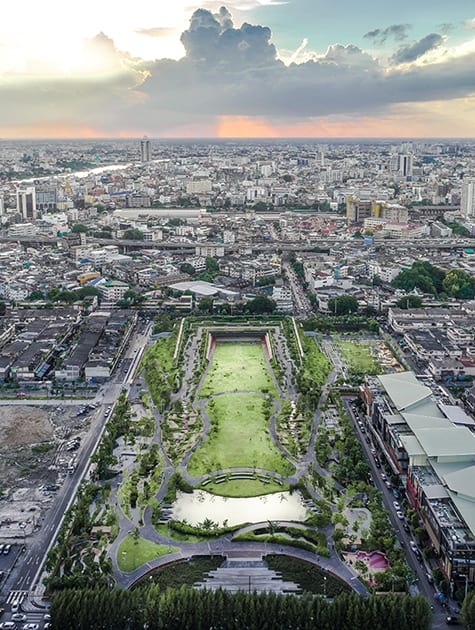The following interview was conducted by Jared Green at the ASLA 2019 Conference on Landscape Architecture in San Diego and published in The Dirt™. This excerpt is reprinted with permission.
 Over the past few decades, how much progress have we made towards achieving sustainable landscapes? What practices promoted through the Sustainable SITES Initiative® (SITES®) have landscape architects now widely adopted? What low-impact material alternatives do landscape architects now widely use?
Over the past few decades, how much progress have we made towards achieving sustainable landscapes? What practices promoted through the Sustainable SITES Initiative® (SITES®) have landscape architects now widely adopted? What low-impact material alternatives do landscape architects now widely use?
In general, we have made strong progress toward sustainable landscapes in some areas. Green infrastructure – including bioretention, bioswales, rain gardens, even green roofs – are now pretty widely used, especially in urban environments. Their performance and cost benefits are well-documented.
Landscape architects are getting a handle on how to employ them in a functional and artful way. Landscape architects are also starting to speak the language of civil engineers and doing great collaborations in the area of stormwater management. This whole area of SITES and sustainable site design has been really successful.
Landscape architects are also designing with native plants and plant communities in mind, and many are avoiding invasive plants. If only we could get the nursery industry to not stock invasive plants, we would be OK. But even in urban settings, landscape architects are conceiving of plant communities as habitat as well as having aesthetic value.

ASLA 2019 Professional General Design Honor Award. Chulalongkorn University Centenary Park, Bangkok, Thailand / LANDPROCESS
Where are the major gaps? Where does progress need to happen the most?
Use of materials with reduced environmental and health impacts are lagging behind. This is because clear and comparable information about the carbon footprint, resource use, manufacturing impacts, and toxicity of materials and products is not widely available.
Information transparency is perhaps the biggest challenge when trying to reduce the environmental and human health impacts of materials and products. LEED, SITES, and the Living Building Challenge offer credits encouraging information transparency, but these credits are still among the least achieved.
Product manufacturers do not provide information on embodied carbon, resource use and waste, energy and water use, and toxicity impacts. Human health impacts may be the most challenging to identify given many manufacturers claim the constituents of their products are proprietary and therefore will not release information on the types of chemicals used or produced and their quantities.
The habitat and cultural impacts of raw material extraction are often an out of sight out of mind issue. For example, we don’t see the impacts of harvesting tropical hardwood lumber from the Amazon, so it doesn’t seem so problematic to use it. We don’t see the ecosystem decline after the removal of the keystone species tree that is cut to make tropical hardwood lumber. We don’t hear about the murders of indigenous people to intimidate them to leave their protected land so tropical hardwoods can be harvested. And we don’t know that there is a 78 percent chance that the tropical hardwood we are using was harvested illegally (Greenpeace 2014).
Read the full interview with Meg Calkins on the ASLA website.
Meg Calkins, FASLA, is the department head and professor of landscape architecture at North Carolina State University. She is a contributing editor to Landscape Architecture Magazine, a founding member of the Sustainable SITES Initiative® (SITES®), and author of Materials for Sustainable Sites: A Complete Guide to the Selection, Evaluation and Use of Sustainable Construction Materials, and The Sustainable Sites Handbook: A Complete Guide to the Principles, Strategies and Best Practices for Sustainable Landscapes.

